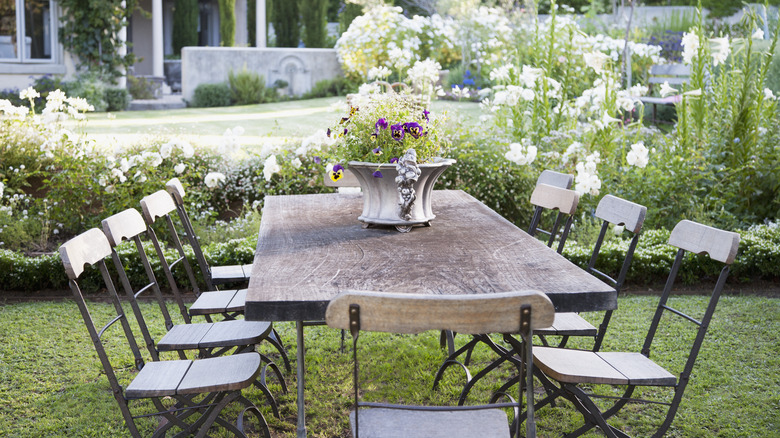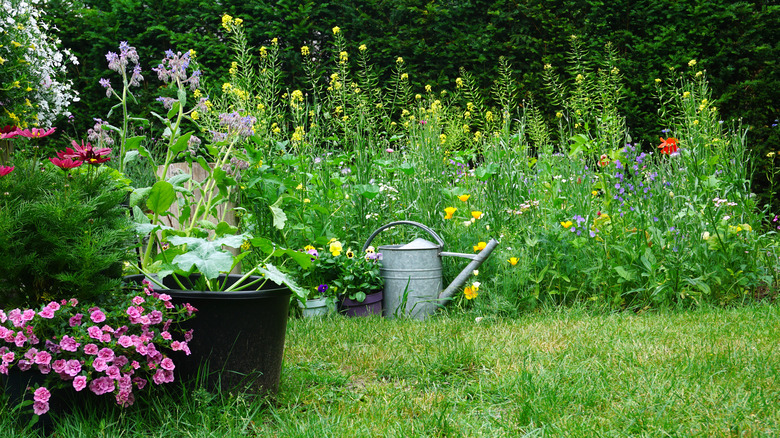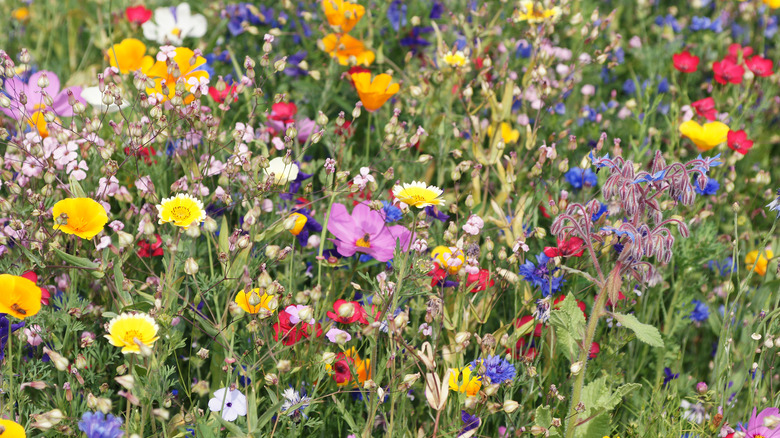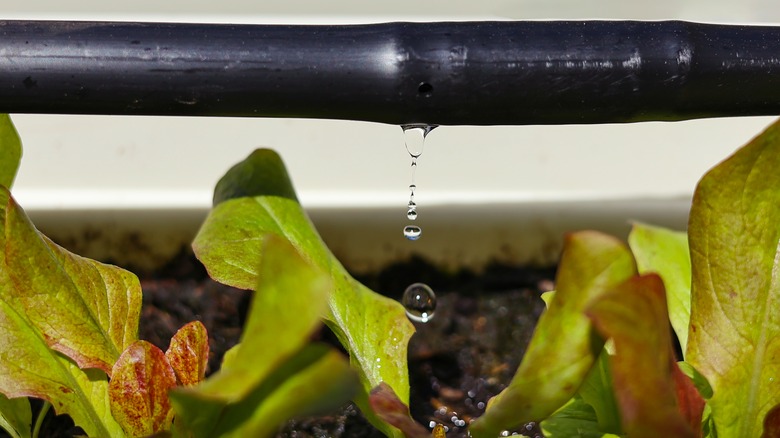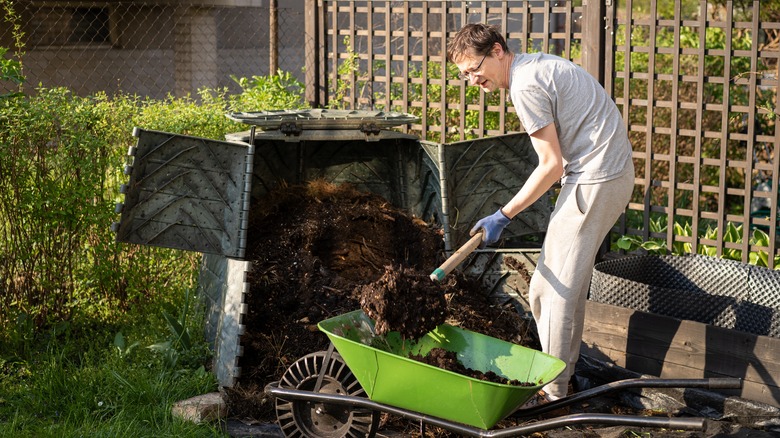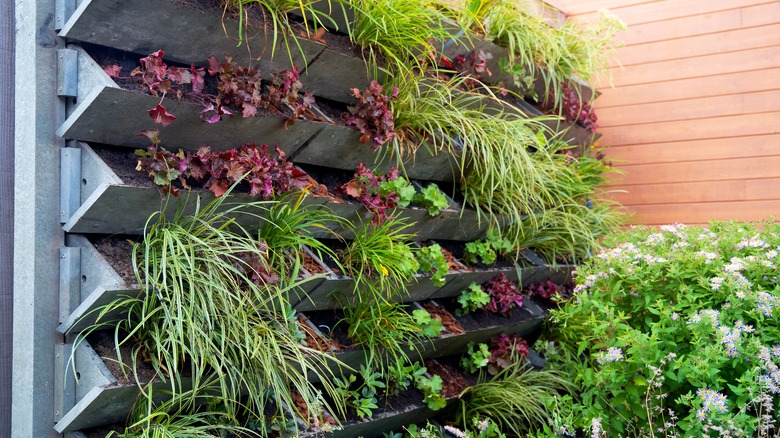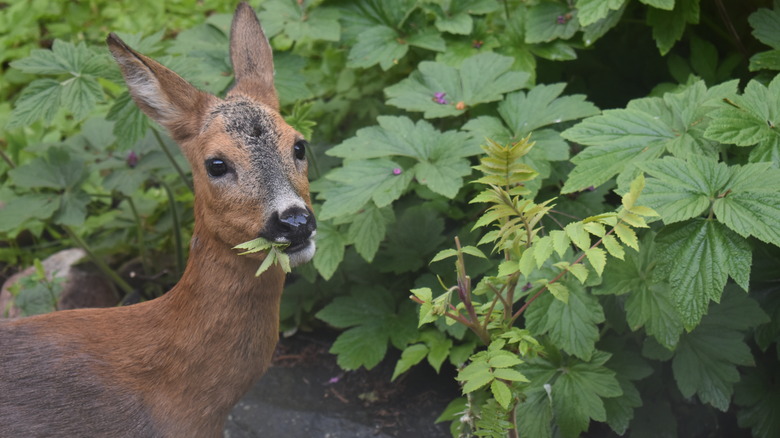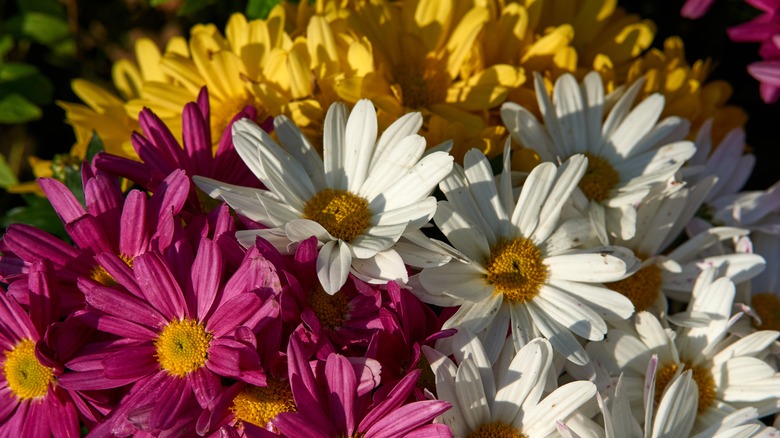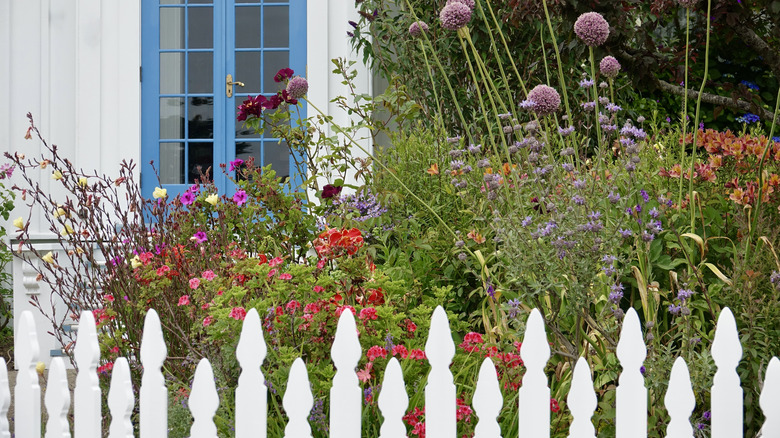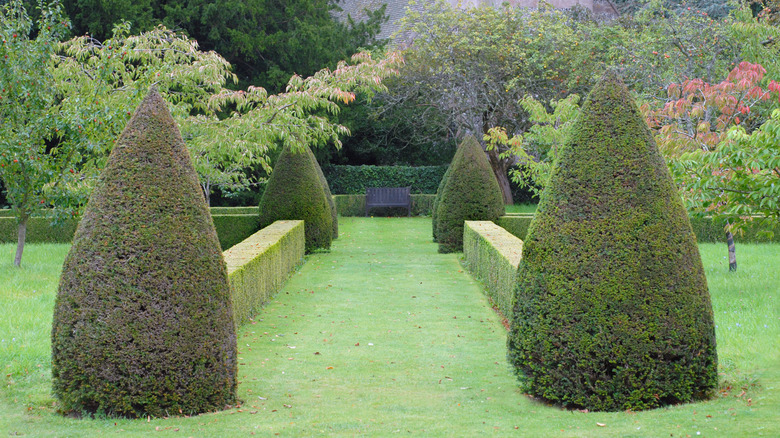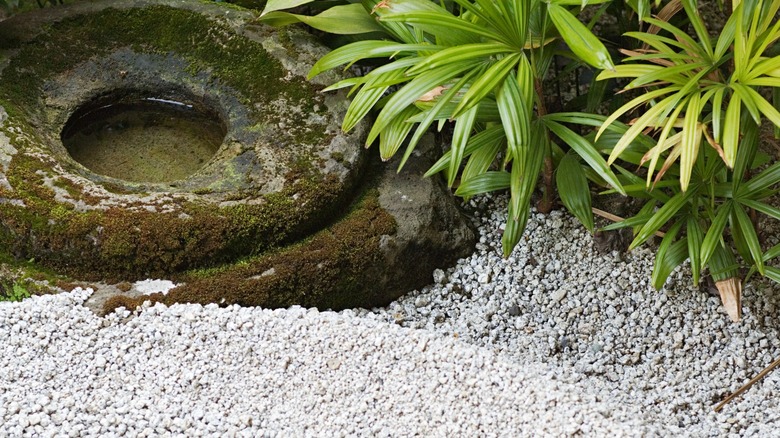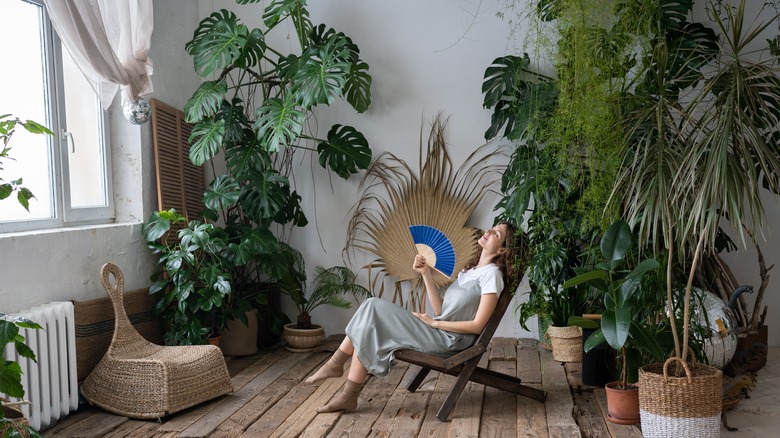These Are The Best Garden Trends Taking Over So Far In 2023
Gardening enthusiasts from beginners to masters continually look for new ideas to improve their gardens. In 2023, several approaches to gardening have already started to stand out as popular trends. From casual vibes to structured landscapes, these allow home gardeners to increase curb appeal and create a space to reflect their individual outdoor interests.
As gardeners become increasingly aware of environmentally-friendly practices, sustainable practices like composting and using organic fertilizers are remaining at the forefront this year. This trend also includes selecting native and drought-resistant plants as well as creating wildlife-friendly spaces. Aesthetically, concepts like a modern take on the Victorian vibe as well as the zen-like Japanese garden are also popular ways to enhance outdoor areas. And, indoor gardening as well as vertical layouts allow flexibility when it comes to creating your own green retreat. No matter what size and type of garden you have, there's a current trend that might inspire you with new ideas in 2023.
Grow plants that are native to your area
You can fill your garden with plants that have a proven track record of successfully thriving in your geographical location. Native plants adapted to climate conditions in your area thousands of years ago. When you include them in your garden design, you can cut back on watering, fertilizing, and pesticides. Keep in mind that the birds, pollinating insects, and wildlife in your location evolved along with these plant varieties, as they use them for food and shelter. Therefore, filling your garden with native plants allows you to live in harmony with nature.
To get started with growing native plants, you should identify the ones that already occupy the space in your garden. Then, do some research to discover the options for plants that are native to your region. Over time, you can replace non-native plants with native ones. Be sure to assess conditions such as sunlight, soil quality, rainfall, and drainage as you select and position them in your garden. Native plants are an important part of your local ecosystem, so planting them benefits humans, animals, and the environment.
Nix the lawn and create a wildflower meadow
Who says you must grow a flat, green expanse of grass for your lawn? In recent years, many homeowners are turning their lawn areas into interesting wildflower meadows, and the trend appears to be even more popular in 2023. A wildflower meadow comprises a variety of native flowering plants and grasses that flourish when planted together. The combinations of annuals, biennials, and perennials in a meadow produce a riot of colors and textures that are pleasing to the eye. Additionally, native butterflies, birds, pollinating insects, and small wildlife are attracted to a meadow.
To get started, you'll need to identify a portion of your lawn for the meadow. Choose a location that gets at least six hours of sunlight daily. Next, you'll need to remove the lawn with a sod cutter or cover it with black plastic for several weeks or months to smother the grass. After removing the turf, you can till the soil to ready it for planting. In northern locations, sow the seeds for a wildflower meadow in spring, after the last frost. In southern climates with mild winters, you can scatter your wildflower seeds in the fall.
Establish a drought-tolerant garden
Water conservation is an important aspect of responsible gardening practices. Therefore, it's helpful to discover drought-tolerant plants and gardening methods that help you save time and money on watering your garden. When you're selecting plants, do some research to find the species that require little or no watering in your area. In most cases, these will be native plants that have been thriving in your location for many years before humans introduced garden hoses and irrigation methods. Consult a well-respected, local nursery to find drought-tolerant plants for your region.
In addition to choosing the right plants, several practices contribute to establishing a drought-tolerant garden. Amend your soil with proper nutrients for plants to flourish. Then, add 3 to 4 inches of organic mulch around your plants to hold moisture in the ground. When you water the plants, avoid using a sprinkler that sprays water that can be evaporated into the air. Instead, use drip irrigation so it slowly seeps into the soil. Avoid fertilizing plants during the driest parts of a drought season and immediately remove any thirsty weeds that pop up, competing for the available water.
Engage in sustainable gardening practices
Show your love for the planet by adhering to eco-friendly principles in planting and maintaining your garden. A number of gardening practices are on-trend to promote sustainability. Water your lawn and garden only when needed, and use drip irrigation or soaker hoses wherever possible. For additional water conservation, place rain barrels under your downspouts to collect water for the garden. Deposit dead leaves and other organic waste in a compost pile. Then, use the natural compost to mulch around your plants for moisture retention and to enrich the soil.
Avoid using fertilizers and herbicides that contain chemicals. Instead, do some research to make your own all-natural alternatives that promote growth and repel pests without harming the environment. Additionally, you can improve your garden's sustainability by adopting no-till planting methods. Tilling the soil every year causes it to lose nutrients, but you can nix the tiller and substitute mulching and composting to maintain the soil's healthy composition. Minimize waste in your garden wherever possible. For example, you can reuse your plastic and clay pots year after year. And, when you do dispose of plastic pots, be sure to take them to a recycling center.
Create a vertical garden
Perfect for small spaces, vertical gardens take plants to new heights. You can create a vertical garden outdoors, indoors, or on a porch or patio by providing a structure for planting that utilizes the space on a wall or other vertical surface. For a vegetable garden, plants such as pole beans, cucumber, squash, and vining tomatoes show increased harvest yield when they grow upward on vertical supports. They can thrive on trellises, fencing, and pergolas as well as sturdy wires or thick string woven between upright poles.
Many vertical garden systems are composed of metal or wood pots or pockets for cultivating individual plants along a vertical structure. DIYers favor wood pallets as low-cost materials for vertical gardens. With the pallet lying flat, fill the empty spaces with soil and plants. After allowing the plants to get established for a few weeks, you can mount or lean the pallet on a wall or fence. Additionally, many manufacturers offer pre-made structures for outdoor and indoor vertical gardens. Especially attractive in urban settings, vertical gardens take up little space while delivering several advantages. They improve air quality, provide shade from the summer heat, block noise, and create a calming atmosphere.
Attract wildlife to your garden
A wildlife-friendly garden allows you to live in harmony with nature. Share your outdoor space with wildlife and enjoy watching the creatures in a natural habitat. If your garden offers shelter, food, water, and places for nesting, you'll attract frogs, birds, and pollinating insects to your garden. Larger mammals like foxes, hedgehogs, and deer may also follow.
Place feeders and nesting boxes around your garden to attract birds. Offer water in a raised basin for feathered friends, but also place a low-to-the-ground water bowl for other creatures. A brush pile, wood pile, or fallen tree provides protection from the weather and a place for nesting. Tall grass around the edge of your lawn offers shelter for small invertebrates, and a pond in the garden can attract frogs and newts.
Gardeners might be picky about the types of wildlife they wish to attract. Rats, mice, and nighttime scavengers such as raccoons and opossums can quickly become a problem. To discourage these creatures, keep bird feeders clean, changing the seed and other food offerings frequently. Keep trash cans covered tightly with sturdy lids, and change any standing water daily to avoid creating a breeding ground for mosquitoes.
Grow colorful flowers for cutting
Vases of flowers contribute an elegant vibe to your home decor. You can eliminate the need to visit a florist shop by growing your own flowers for bouquets and tablescapes. In fact, cutting gardens are on-trend in 2023. These bright blooms can come from annuals, perennials, biennials, and bulb plants. For the best results, it's helpful to research the recommended flowering plants for your agricultural zone.
Select a sunny and well-drained location for your cut-flower garden, and enrich the soil with a slow-release fertilizer. You can start the flowering plants from seed, or you can transplant seedlings into the garden. Annuals such as zinnias and sunflowers make beautiful bouquets while climbing plants like sweet pea and nasturtium produce prolific flowers when trained on trellises. You can ensure continuous production of flowers throughout a season by staggering your plantings two-to-three weeks apart. Savvy Gardening also recommends applying a liquid, organic, flower fertilizer every two to three weeks. To promote continued blooming throughout the season, be sure to remove any dead blooms from the plants.
Create a cottage garden
Increase your home's curb appeal with a colorful and inviting cottage garden. These quaint landscaping designs can complement the architectural styles of everything from bungalows and farmhouses to log cabins and traditional homes. A cottage garden does not feature straight edges and neatly spaced plantings. Instead, the overall impression is that the garden is minimally planned. Wide planting borders, winding pathways made from natural materials, and dense plantings of colorful, flowering plants characterize the design.
To get started, choose a sunny location, preferably in the front yard. Place stones or pea gravel to construct curving walkways leading to the front door and throughout the garden area. Then, add wooden structures such as arbors or rustic gates, and develop organically-shaped borders with flowering plants and soft-edged shrubbery. Finally, fill the garden primarily with perennial plants. Select plants judiciously to always have something in bloom throughout the seasons. To create relaxing spaces to enjoy your new garden, add benches or other outdoor furniture for lounging.
Design a Victorian garden
During the Victorian era, spacious and well-manicured lawns became the must-have setting for outdoor parties. Smooth, green, grass first came into fashion during this period, making it a staple foundation of the garden's design. Rows of trees flank driveways and walkways, and neatly trimmed hedges form organized patterns that are pleasing to the eye. You too can establish a beautiful outdoor space by employing the formality and structure of Victorian design in a modern-day garden.
To develop a Victorian garden in your landscape, think of clean lines and geometrical shapes. Use gravel to create pathways, and establish structure with densely planted shrubbery that can be trimmed into neat rows or topiaries. Plant flowering plants in well-ordered beds for a burst of color while maintaining order. Then, place stone structures throughout the garden, including sundials, planting urns, and statues. You can also use the structure of trees, shrubbery, trellises, and arbors to create distinct rooms within the garden. Enjoy our new space and encourage socializing by placing ornate metal benches, chairs, and tables within these rooms.
Plant a serene garden with Japanese influence
Japanese gardens are known for their simplicity and elegance. If you'd like to create a zen-like sense in your backyard, try introducing these peaceful elements. Instead of grass lawns, Japanese gardens feature open spaces covered with moss or fine gravel and large, carefully spaced, jagged rocks. Large plants such as slow-growing Japanese maple trees, pruned azaleas, and junipers, contribute a sculptural look to the garden. The design aesthetic incorporates clean, curving lines and visually pleasing vistas. A Japanese garden should provide a tranquil scene for sitting or when viewed through a window in the home.
Water is an important element in a Japanese garden. Koi ponds, waterfalls, and streams become central garden features. Additionally, small fountains may be tucked under trees or large plants. Bamboo is used extensively in Japanese gardens to construct trellises and screens while natural stone pathways invite visitors to stroll through the foliage. Japanese-style stone lanterns, wooden pergolas, and potted bonsai trees may be placed throughout the garden to be discovered by those who wander through the space.
Collect houseplants for a lovely indoor garden
You can never have too many houseplants, right? Enthusiasts tend to add to their collections of houseplants over time, and indoor gardening is a popular trend in 2023. Caring for the household flora becomes a relaxing hobby, and sharing your indoor living space with plants can provide mental health benefits. On top of that, you can design your home decor around an indoor garden for maximum aesthetic impact.
An indoor garden might be as small as a window sill, or it can occupy a large, sunny corner of a room. You can display plants in attractive pots on stands, place them in containers that hang from the ceiling, or grow a vertical garden that covers a wall. If you don't have a sunny indoor location, choose low-light plants like philodendron, snake plant, parlor palm, and peace lily. But, if plenty of natural sunlight floods through your windows, you can grow aloe vera, hibiscus, Areca palms, and dwarf gardenias. If you decide to use grow lights, Planet Natural recommends that you choose a type that uses high-intensity discharge (HID) light bulbs to help your plants thrive.
